Drawing a Boat: Techniques for Nailing Shapes and Reflections
Picture yourself standing on the dock, looking at a serene lake where a majestic sailboat gently rocks. You grab your pencil and paper, eager to capture the tranquility.
However, as you start drawing, your boat seems more perched on top of the water than floating in it.
Sound familiar? You're not alone!
Many artists find it challenging to depict a boat realistically in water.
I'll guide you through effective steps to draw realistic boat shapes, reflections, and ripples that will make anyone that looks at your art feel as if they are right there with you at the edge of the water.
Getting the shape right when drawing a boat
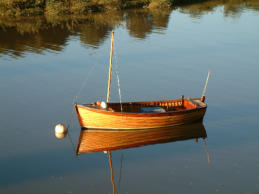 Boat on the River Tamar
Boat on the River TamarMany artists struggle to accurately depict the unique shapes and proportions of boats. The primary challenge is understanding how a boat's design varies with its intended environment.
River and lake boats have flatter bottoms and wider beams for stability on calm waters. In contrast, ocean-going vessels feature a narrower, more V-shaped hull to slice through waves and maintain balance in rough conditions.
Neglecting these distinctions can result in unrealistic drawings, with boats looking top-heavy or unstable.
In this section, we'll explore the fundamental principles that govern boat shapes, enabling you to create accurate and visually appealing boat drawings.
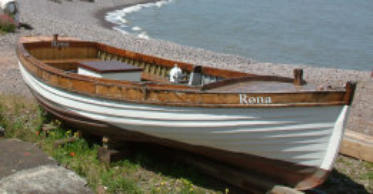 Small, sea going boats photographed in Somerset (Rona) and Whitby, Yorkshire
Small, sea going boats photographed in Somerset (Rona) and Whitby, Yorkshire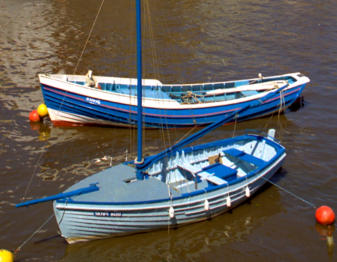
Drawing a River Boat Outline
Let's start by sketching a simple river boat outline, focusing on a design with gentle curves.
To ensure our boat is drawn with the correct perspective, we'll use a rectangular guideline box.
Begin by drawing the box in perspective, marking the centre line at the front and back. Then, draw the boat's shape within the box, which will help you achieve the correct curves and sides, as well as position the bow in the middle.
The two graphite sketches below demonstrate this approach, showcasing boats hauled up on a beach.
When drawing a boat in the water, the view will naturally differ.
By applying this technique, you'll be able to create a realistic and visually appealing river boat outline.
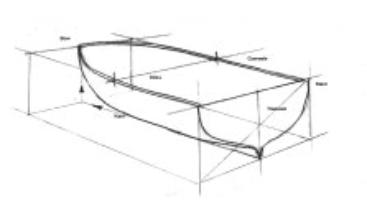
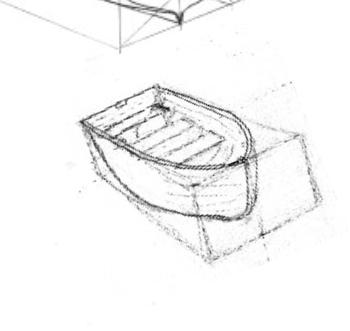
Drawing a Coastal Boat: Mastering the Curves
When it comes to drawing a coastal boat, the task becomes more complex due to the pronounced rise of the bows and the unique curves of the hull.
Unlike river boats, coastal boats have a more V-shaped hull, which creates complex problems for accurate drawing, especially when viewed from a side angle.

To tackle these challenges, we can use a clever technique to determine the correct curves of the hull.
Observe how the gunwale flows and how the curves appear to go in opposite directions on either side of the top of the boat. This shape can be described as a flattened figure eight.
Let's explore this concept further. By drawing a figure eight shape on its side and developing it into a boat, we can create a versatile outline that can be adapted to various views.
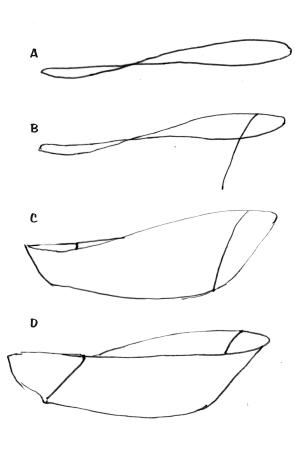
In Figure A, we start with the basic outline of the flat figure eight. With practice, you'll find that most shapes of "eight" will produce a suitable top outline for the boat hull.
Next, we can decide on the orientation of the bows and stern. In Figure B, I've positioned the bows to the right.
Then, we can choose whether the boat is facing towards us (Figure C) or away from us (Figure D). By erasing and adding lines strategically, we can create different views of the boat while maintaining accuracy.
To demonstrate this versatility, I've used the same figure eight outline to create an alternative hull shape in Figure E, showcasing how this technique can be adapted to draw a boat facing in a different direction.
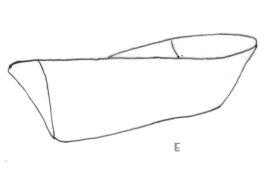
Remember, the drawn figure eight shape is only a guide; don't be afraid to deviate from it as you refine your drawing.
The goal is to master those difficult opposing curves along the top edges. Once you've added your finishing lines, any surplus drawn lines can be erased.
Clinker Built Boats: Traditional vs Modern
As we explore the world of boat drawing, it's essential to understand the differences between traditional clinker built vessels and their modern counterparts. When drawing a boat, it's not just about capturing its shape, but also its construction and history.
Traditional clinker built boats, like "Rona" and the two boats at Whitby, feature overlapping planks of wood that follow the curves of the hull. This unique construction method creates a distinct visual appeal.
In contrast, modern boat building has introduced glass reinforced plastic (GRP) boats that mimic the look of traditional clinker built vessels, but are created from a full-sized mould.
On the other hand, many river and shallow water boats have smooth, surfaced outside hulls, often built from sheet ply or GRP. While these boats may lack the artistic interest of traditional clinker built vessels, understanding their construction and design is critical for creating accurate and visually appealing drawings.
Drawing Boats in Water: The Importance of Displacement

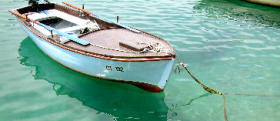
When drawing a boat in water, it's essential to remember that boats move through and sit in the water, not on top of it.
Observe how the weight of the boat and its occupants affects its displacement in the water. In the example (above), the foreground boat is low due to the weight of the two fishermen and their nets and tackle. Notice how this displacement creates a curve at the waterline, which is more pronounced when viewed from a lower angle.
Keep in mind that your perspective will influence the curvature of the hull. The higher your vantage point, the more pronounced this curve will be.
By incorporating these considerations into your drawing, you'll be able to create a more realistic piece of art.
Capturing Realistic Water Reflections and Ripples
We have added an extra page with photographs and information about drawing reflections.
Now that we've explored the fundamentals of drawing boats, let's look at water reflections and ripples.
Understanding how to depict these elements accurately will help you when drawing a boat on water.
The Angle of View: A Key to Reflections
Observing a still water surface from above, reveals either the bottom or a reflection of the sky and surroundings.
At an angle of approximately 45 degrees, you can see the shift from seeing into the water's depth to observing its reflective surface.
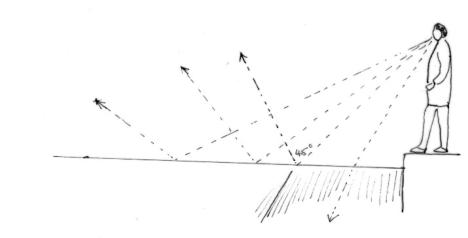 At around 45 degrees off-center, the view starts to merge and distort. It's not a hard cutoff, but a gradual blending.
At around 45 degrees off-center, the view starts to merge and distort. It's not a hard cutoff, but a gradual blending.Ripples and Their Impact on Reflections
Slight waves alter the viewing angle, altering the water's appearance between light and dark.
Angles sharper than 45 degrees generally result in a darker appearance, while angles greater than 45 degrees make it look lighter.
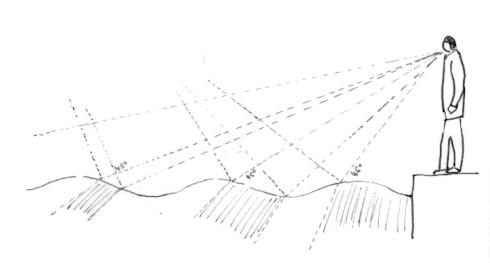
This interplay results in the varied light and dark patterns seen on rippled water surfaces.
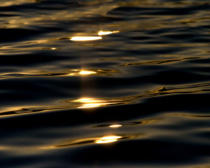
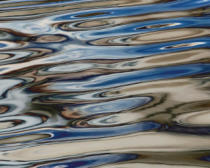
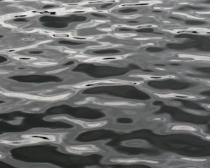
Reflections and Moving Objects
When drawing a boat reflected in the water, calculations become more complex.
The boat’s movement, weight, and wake affect how reflections are cast on the water.
External factors such as weather conditions and the width of the waterway also play roles in how these reflections distribute across the surface.
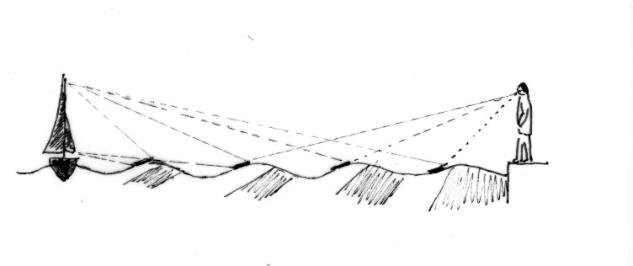
Usually, we see the image on the left below, but the image is often broken up by the varied surface angles. Sometimes we see the picture on the right, where the reflected image in the water is also broken up. The theory predicts the picture on the left, but in practice the picture on the right is more often seen.
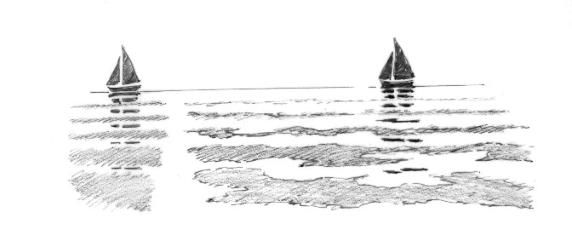
Things to Keep in Mind When Drawing Reflections
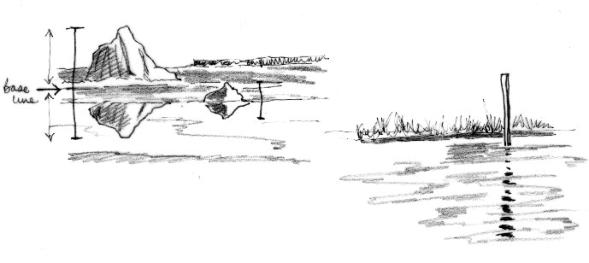
There is a section of broken water near to the large rock in the sketch above and that breaks up the reflection.
The temptation might be to measure our reflection from the edge of the broken water.
This would be wrong. We need to measure the equal distance from the base of the rock so our reflection in the calm water only shows the top of the large rock. The small rock is on the edge of the calm water so all the reflected image is shown.
When ripples occur, they can disrupt our calculations and make the reflected image appear longer than the original.
This happens because the wave-like structure of the water is picking up the reflection over a larger distance, similar to the drawing on the right. Additionally, the width of the reflected image may also be affected by the angle of the water.
I hope this page has given you some pointers for the next time you are drawing a boat in or off water, along with its reflection.
Ready to Set Sail?
Congratulations for reading this far. By now you may feel overwhelmed by the wealth of information and techniques I’ve shared.
However, to become adept at boat drawing, just take it one step at a time.
Start by practicing the simple river boat outline exercise, focusing on getting the shape and proportions right.
Remember, the goal is to create a visually appealing and accurate depiction of a boat.
By taking this first step, you'll build confidence and lay the foundation for more complex drawings. So, grab your pencil and paper, and set sail on your artistic journey!
- Home
- Landscape drawing
- Drawing a boat


